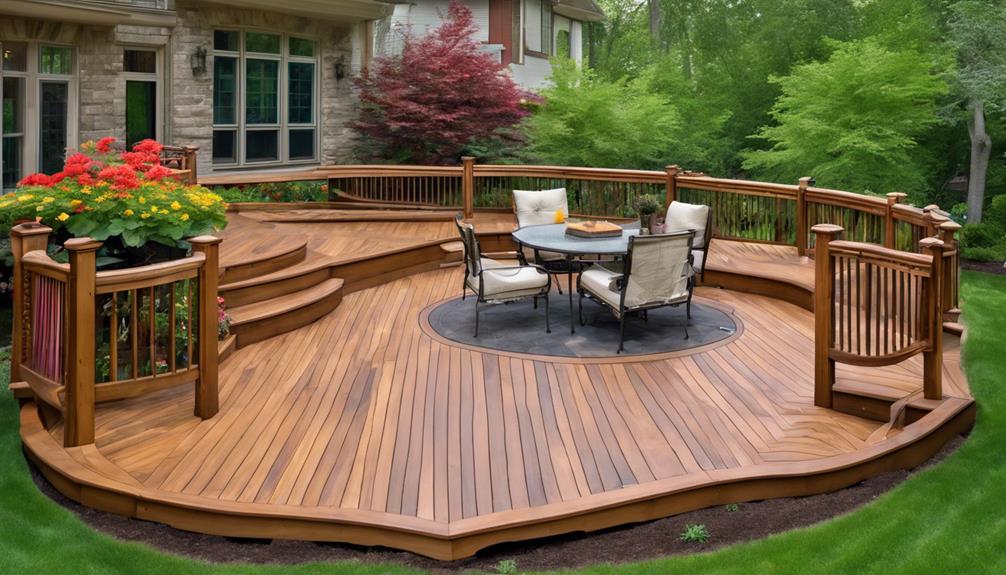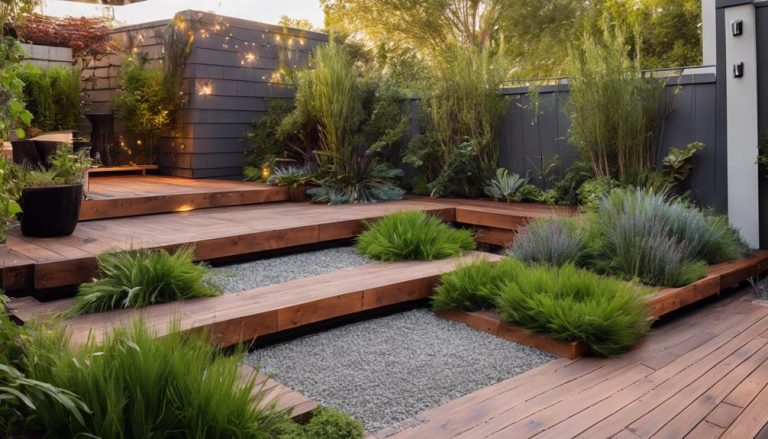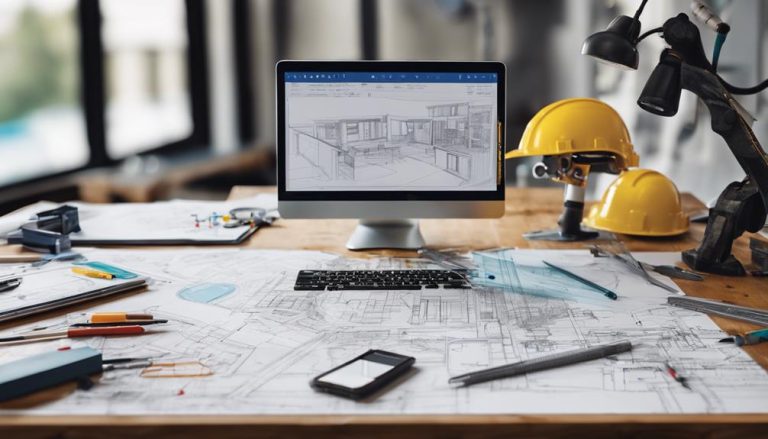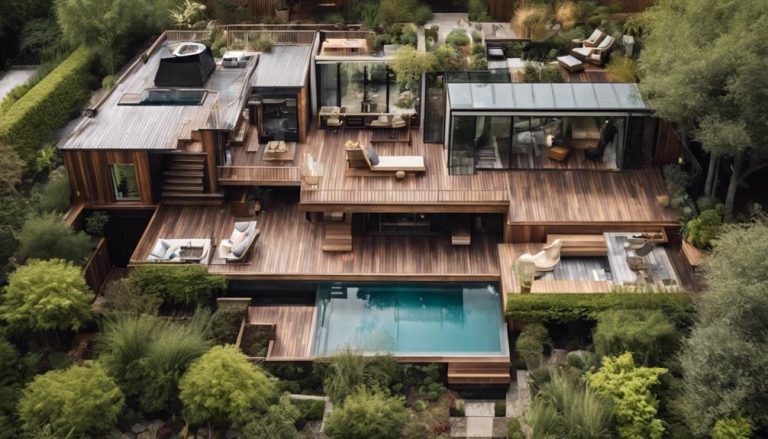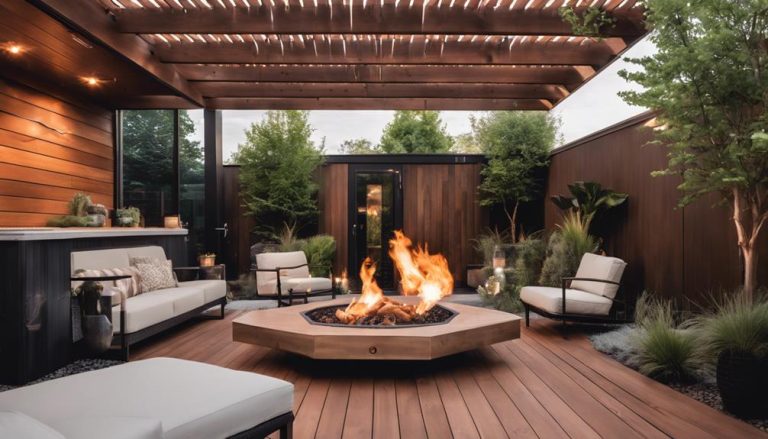How to Choose the Right Custom Deck Design for Your Home
Choosing the right custom deck design for your home requires a nuanced approach, focusing on translating your vision into a cohesive and aesthetically pleasing structure. Consider the purpose and spatial relationship of the deck, ensuring compliance with safety standards and aligning with your home's architectural style. Explore material options like hardwoods, composites, and eco-friendly alternatives that cater to both aesthetic preferences and environmental impact. Tailor aesthetic features such as color palettes, railing designs, and lighting to enhance functionality and visual interest. A well-conceptualized deck not only expands your living space but considerably boosts your home's market appeal. Discover the elements that can transform your outdoor area into a personal haven.
Deck Builder Highlights
- Assess the deck's purpose to determine layout and suitable features tailored to your home's needs.
- Choose materials that align with climate, deck usage, and personal preference for durability and aesthetics.
- Integrate the deck design with your home's architectural style for a cohesive appearance.
- Personalize aesthetic features like railings and lighting to match your taste and enhance utility.
- Opt for eco-friendly materials to minimize environmental impact and prioritize sustainability.
Defining Custom Deck Design

A custom deck design begins with understanding fundamental design principles, which serve as the blueprint for blending functionality with aesthetics in outdoor spaces.
The deck as living space concept emphasizes the importance of creating a seamless shift between indoor and outdoor areas, enhancing both beauty and usability.
Selecting from a variety of material options enables homeowners to tailor their decks to suit durability needs and stylistic preferences, ensuring longevity and visual appeal.
Personalization further enhances this design process, allowing the integration of unique aesthetic features that reflect individual taste and complement the home's architectural character.
Understanding Design Basics
Custom deck design is the art of tailoring outdoor spaces to align with homeowners' preferences, lifestyles, and functional needs. It involves translating personal vision into a structured and aesthetically pleasing reality, guaranteeing the final structure complements both the home's architecture and surrounding environment. Understanding the design basics is essential for creating a harmonious balance that fuses creativity with practicality.
To begin, consider the deck's purpose—is it for entertaining, relaxation, or enhancing the aesthetic appeal of the property? Clarity in purpose aids in structuring the layout, determining the suitable size, and selecting features like seating, lighting, or planters that seamlessly integrate into the design.
Additionally, the spatial relationship between the deck and key elements of the home or garden should be assessed to enhance usability and flow. Moreover, regulations such as building codes and permits influence the deck's design, mandating compliance with safety standards and structural integrity. The style choice—be it contemporary, traditional, or rustic—must also reflect the personal taste yet respect the existing architectural style of the home. In-depth consideration of design basics not only guarantees a cohesive outdoor environment but also adds lasting value and function to the property.
Exploring Material Options
Once the foundational principles of design are in place, attention naturally shifts to the selection of materials that will bring the custom deck to life. Choosing the right materials is pivotal, as it influences not only the aesthetics but also the durability, maintenance requirements, and overall performance of the deck. Common material choices often include wood, composite, and PVC, each possessing unique characteristics suited to various preferences and environmental conditions.
Traditional hardwoods, like redwood and cedar, are renowned for their natural beauty and resistance to decay; however, they demand regular maintenance to sustain their appearance and structural integrity. Conversely, composite decking, crafted from a blend of wood fibers and plastic, offers the allure of wood with reduced upkeep, resisting warping, splintering, and fading.
PVC decking, composed entirely of synthetic materials, stands out for its exceptional durability and resistance to weather elements, demanding minimal maintenance while providing a sleek, modern finish.
While the budget can steer material selection towards more economical or luxurious options, considering factors such as climate, deck usage, and personal preferences guarantees that the chosen materials align with the homeowner's vision and the deck's intended longevity. Careful consideration of these material attributes will guide the creation of a customized deck that is both aesthetically pleasing and functionally reliable.
Personalizing Aesthetic Features
Harnessing creativity in the domain of custom deck design involves tailoring aesthetic features that transform an outdoor space into a personalized sanctuary. To achieve this, homeowners can integrate a cohesive blend of elements that reflect their individuality while complementing the architectural style of the surrounding structure.
Begin with selecting a color palette that harmonizes with the home's exterior, taking into consideration the natural landscape and seasonal changes. Incorporating contrasting hues can accentuate focal points, guaranteeing a visually striking design.
Attention to detail is paramount, with intricate railing designs, customized balusters, or unique post caps providing additional opportunities for personalization. Material choices such as wrought iron, glass, or specialized wood finishes can profoundly alter the perception and ambience of the deck. Lighting solutions, from subtle recessed lights to elegant fixtures, can set the mood and enhance functionality after dusk.
Furthermore, integrating built-in features such as benches, planters, or pergolas can elevate the utility and aesthetics of the deck. These elements, when meticulously chosen and placed, guarantee a seamless blend with nature, prompting relaxation and entertainment. By meticulously personalizing these aesthetic features, one's custom deck becomes a reflection of personal style, offering tranquility and inviting reflection.
Benefits
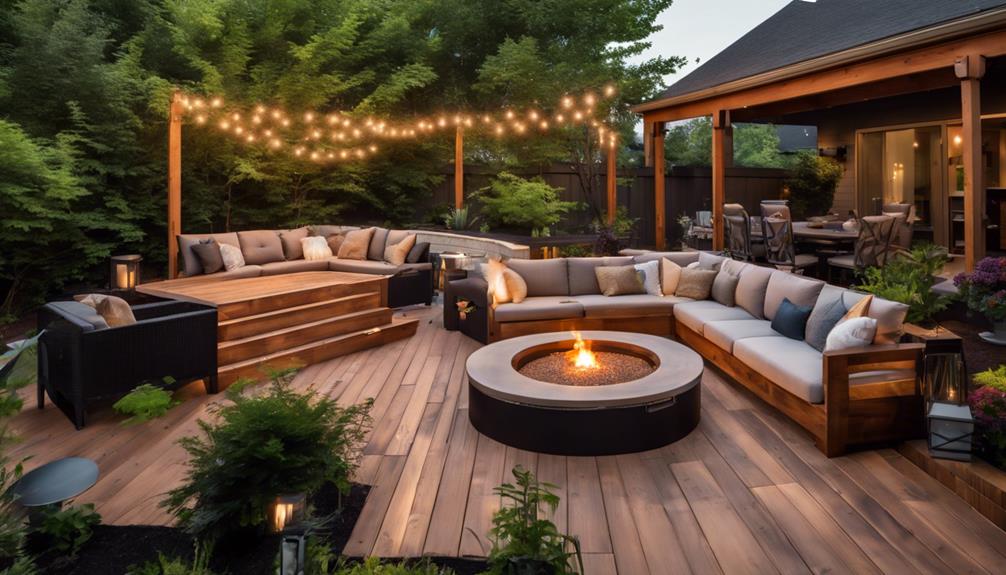
Opting for a custom deck design offers the notable benefit of enhancing one's outdoor living space, creating an area that seamlessly extends the home's functionality and aesthetic allure. A well-crafted design not only reflects the homeowner's personal style but also guarantees a cohesive outdoor living space, nicely integrating with the surrounding landscape.
Such a personalized addition not only augments the homeowner's pleasure but also contributes to an increase in the property's market value, presenting an attractive proposition for future resale. Additionally, by tailoring the deck's design to suit individual tastes, it fosters an inviting environment that can facilitate memorable family gatherings, making the deck a central hub for social interaction.
Enhancing Outdoor Living Space
A well-designed custom deck can considerably enhance outdoor living space by providing a seamless extension of the home that is both functional and aesthetically pleasing. By bridging indoor comfort with outdoor allure, a custom deck fosters an environment conducive to relaxation, entertainment, and enjoyment of natural surroundings. Such a deck can be tailored to match the architectural style of the existing structure, incorporating materials and finishes that harmonize with the home while meeting the specific needs and preferences of homeowners.
From simple, elegant platforms perfect for quiet reading to expansive, multi-level terraces with integrated seating, lighting, and landscaping, custom decks present endless possibilities for transforming unused outdoor areas into vibrant living spaces. The strategic use of design features, such as pergolas for shade and planters for greenery, can considerably enhance the usability and ambiance of the space, making it a valuable addition to any home.
Additionally, by facilitating easy access to the outdoors, a custom deck encourages regular use, allowing inhabitants to benefit from fresh air and sunlight. Thoughtful planning and execution of a custom deck can, in turn, cultivate an inviting outdoor retreat that complements and elevates the overall living experience.
Increasing Home's Market Value
Beyond their capacity to enhance outdoor living spaces, custom decks can substantially increase a home's market value. In today's real estate market, where buyers often seek properties that provide both function and charm, a well-designed deck serves as a compelling feature that can lead to a higher selling price. According to real estate professionals, the addition of a deck often represents one of the highest returns on investment in terms of outdoor enhancements. The financial advantage stems from the added living space and aesthetic appeal that modern homebuyers find desirable.
When crafted from high-quality materials and designed to complement the architectural style of the home, custom decks not only attract potential buyers but also command higher offers. This platform for outdoor entertainment and relaxation, when seamlessly integrated with the home's existing structure, can be perceived as an extension of its interior living space. This perception is vital in real estate, as more homeowners and buyers are valuing multifunctional outdoor areas.
Moreover, a custom deck speaks volumes about a homeowner's commitment to maintenance and care for the property, reflecting positively in market appraisals. Investing in a custom deck thereby yields significant dividends by making a residence more attractive in a competitive market.
Personalizing Aesthetic Preferences
Tailoring a custom deck to align with your aesthetic preferences offers numerous advantages that enhance both personal satisfaction and property appeal. By integrating your unique style preferences into the design process, the deck becomes a natural extension of your home, fostering a sense of harmony and cohesiveness. The ability to choose specific colors, materials, and design elements—such as railings, balustrades, and lighting—ensures that the deck resonates with your personal tastes, making it not only functional but also visually appealing.
In terms of material selection, the options range from classic wood to modern composites, each bringing different textures and color palettes that can complement or contrast with existing home elements. This level of customization allows homeowners to reflect their personalities and achieve a bespoke aesthetic that goes beyond standard designs. Additionally, a well-personalized deck can serve as a focal point for landscaping, enhancing the outdoor environment and making it more inviting.
Aesthetically tailored decks also contribute to long-term satisfaction, as homeowners are more likely to cherish an outdoor space that feels uniquely theirs, as a symbol of their vision and creativity in achieving a personalized living environment.
Promoting Family Gatherings
For many families, a custom-designed deck serves as an ideal setting for gatherings, fostering a space where members can come together to create lasting memories. A well-crafted deck transforms any ordinary backyard into a quintessential hub for social interaction, where both casual afternoons and cherished celebrations can be enjoyed. By utilizing thoughtful design choices, such as ample seating arrangements, integrated lighting, and strategically placed amenities like a fire pit or an outdoor kitchen, custom decks provide a versatile environment that caters to diverse family activities.
Such a space encourages family bonding by offering a picturesque backdrop to host barbecues, birthday parties, or quiet evenings under the stars. The aesthetic charm of a personalized deck, combined with its functional aspects, enhances the overall allure of your home, making it a welcoming retreat for loved ones. Additionally, decks constructed with durable materials support safety and longevity, sustaining years of gatherings and shared moments.
Incorporating features like weather-resistant furniture and shaded areas also allows for outdoor enjoyment across seasons, extending the use of the deck throughout the year. Ultimately, a custom deck not only elevates the value of a property but also enriches family life by nurturing an inviting setting for connection and relaxation.
Material Selection Guides
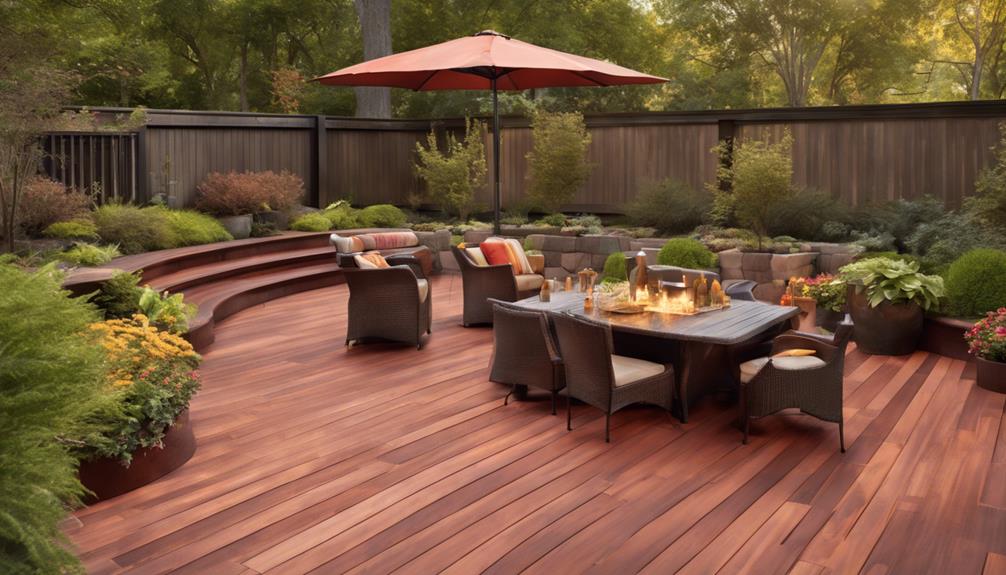
When selecting materials for a custom deck, it is vital to balance durability, aesthetics, and environmental impact, considering choices ranging from traditional wood to modern composites and eco-friendly materials. Durable wood options offer a natural appearance and resilience, while composite and PVC materials provide low-maintenance, long-lasting solutions, each with distinct performance characteristics. Exploring eco-friendly alternatives can reduce environmental footprints, making sustainable choices increasingly significant for many homeowners.
| Material Category | Key Considerations |
|---|---|
| Durable Wood Options | Natural, Resilient |
| Composite | Low-Maintenance |
| PVC | Long-Lasting |
| Eco-Friendly Options | Sustainable Choice |
| Environmental Impact | Reduced Footprint |
Durable Wood Options
Selecting durable wood options for your custom deck can dramatically enhance both its longevity and aesthetic appeal. The choice of wood plays a critical role in the intricate balance between beauty, durability, and maintenance requirements. To make an informed decision, it is crucial to contemplate wood species known for their resilience and resistance to the elements.
- Ipe (Brazilian Walnut): Known for its exceptional hardness and natural oils, Ipe is highly resistant to rot, insects, and wear, making it an excellent choice for outdoor decking. Its rich, dark color also makes it a visually appealing option, though it may require periodic re-oiling to maintain its hue.
- Redwood: Celebrated for its remarkable resistance to decay, redwood is a popular option for decks in damp climates. Its natural tannins act as preservatives, offering a beautiful, rich hue that can last for years when properly maintained.
- Cedar: A lightweight yet durable option, cedar is revered for its natural ability to resist moisture, rot, and insect damage. Its fine grain and warm colors add timeless elegance to any custom deck design.
- Mahogany: Prized for its strength and fine grain, mahogany is naturally resistant to deterioration. Its reddish-brown color can enhance your deck's elegance, especially with regular cleaning and sealing.
Composite vs. PVC
Understanding the differences between composite and PVC materials is crucial for making an informed decision about your custom deck. Both materials offer distinct advantages, and selecting the right one depends on various factors such as durability, maintenance, cost, and aesthetic preference.
Composite decking is often made from a blend of wood fibers and plastic, offering an authentic wood-like appearance combined with resistance to weathering and decay. This material typically requires less upkeep than traditional wood, as it resists termites and rot; however, it can be vulnerable to staining and may fade over time, necessitating periodic cleaning to maintain its look.
On the other hand, PVC (polyvinyl chloride) decking is wholly synthetic, providing a formidable defense against environmental damage, moisture infiltration, and pests. PVC is remarkably lightweight yet robust, making it a popular choice for homeowners seeking long-lasting structures. Its color fastness and resistance to scratches outperform many alternatives, making it preferable for high-traffic areas. However, the initial cost of PVC can be higher than composite decking, a consideration that may impact budget-conscious decisions.
Ultimately, the choice between composite and PVC should align with your personal preferences and functional requirements, ensuring your custom deck enhances your home's outdoor living space while fulfilling practical needs.
Eco-Friendly Alternatives
As homeowners weigh the benefits of composite and PVC decking, eco-friendly alternatives present an attractive option for those committed to sustainability. These materials not only minimize environmental impact but also cater to users seeking durability and aesthetic appeal. With growing awareness of ecological conservation, responsibly sourced decking materials have gained prominence in the market. Selecting these options involves knowledge of material properties, supply chains, and lifecycle impacts.
- Bamboo: Fast-growing and renewable, bamboo is a popular choice for those seeking sustainable decking. When harvested responsibly, it provides a resilient surface with a natural appearance, suitable for various environmental conditions.
- Recycled Plastic: This material is made from post-consumer waste like plastic bottles, transformed into durable planks equipped to withstand harsh weather. By choosing recycled plastic, homeowners contribute to waste reduction and support circular economy principles.
- Reclaimed Wood: Salvaged from old structures, reclaimed wood adds character and elegance to decks while promoting resource conservation. Each piece carries unique qualities, providing an authentic and vintage ambiance.
- Thermally Modified Wood: This option involves heat treatment, enhancing durability and resistance to decay without the use of harmful chemicals. It is an innovative approach offering a compromise between aesthetics and eco-consciousness.
Choosing eco-friendly alternatives requires balancing personal style with environmental responsibility, ensuring longevity and impact reduction.
Decks FAQ
How Do I Determine the Best Size for My Custom Deck?
To determine the ideal size for your custom deck, consider the intended use, available outdoor space, and budget constraints. Additionally, assess local regulations and anticipate future needs to guarantee the deck's functionality and aesthetic integration with the home.
What Are Some Popular Design Trends for Custom Decks in 2024?
In 2024, popular custom deck design trends emphasize sustainability with eco-friendly materials, seamless indoor-outdoor shift, multi-level layouts for functionality and aesthetic appeal, and the integration of smart technology for enhanced lighting and climate control.
How Can I Ensure My Deck Design Complements My Home's Exterior?
To guarantee your deck design complements your home's exterior, consider matching materials, colors, and architectural styles. Collaborate with a professional designer to integrate aesthetic elements, confirming that the deck seamlessly blends with your home's overall appearance.
Are There Specific Safety Considerations for Multi-Story Deck Designs?
Multi-story deck designs require attention to structural integrity, load-bearing capacity, and compliance with local building codes. Incorporating safety features, such as sturdy handrails, slip-resistant surfaces, and appropriate lighting, guarantees the safety and functionality of elevated deck structures.
Can I Install Customized Features Like Lighting or Built-In Seating Later?
Yes, customized features such as lighting or built-in seating can be installed at a later stage. It's critical to guarantee that the initial deck structure allows for future modifications without compromising its integrity or compliance with local codes.

